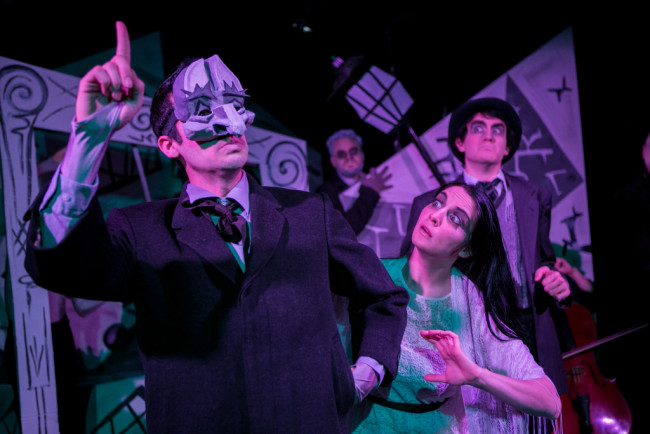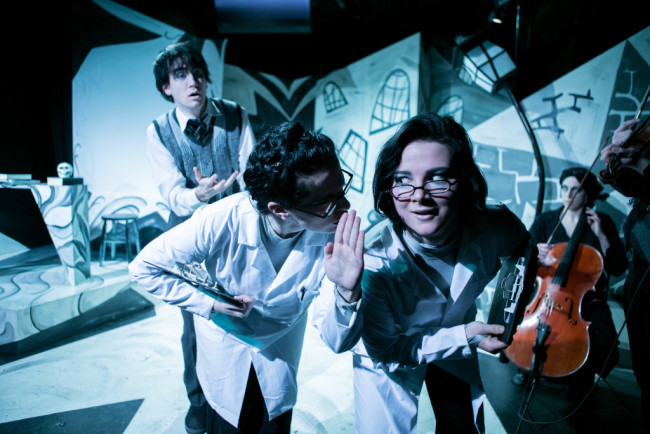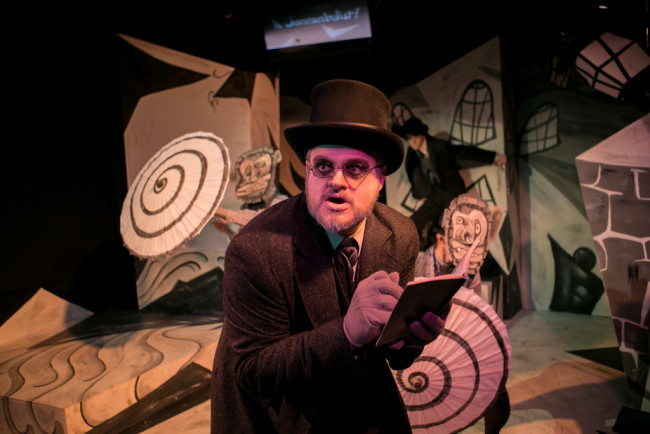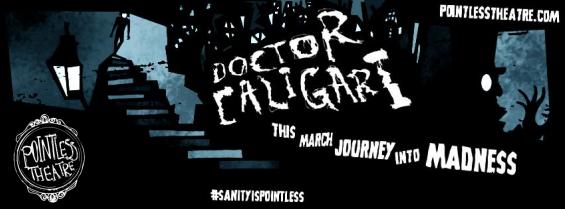Ladies and Gentlemen! Step Right up! Witness the marvelous morose, the wondrous strange, the nightmares that inspire ephemeral fantasticality! Pointless Theatre presents an honest theatrical masterpiece with their production of Doctor Caligari, a devised theatrical ensemble extravaganza that entrances the mind, stimulates the senses, and shakes the core of reality in a surreal and fascinating fashion. Directed by Matt Reckeweg, this homage to the 1920 German Expressionist film The Cabinet of Dr. Caligari unsettles the nerves, unwinds the psyche, and disfigures reality in such a way that will haunt your imagination for many nights to come.
The experience to say the least is ineffable. Imagine a silent film in a Tim Burtonesque world where the screen dissolves like the Twilight Zone and you the audience are pulled into the midst of the film’s actions. This is the closest words will come to encapsulating the sensations of Pointless Theatre’s production. The creative team, who executes flawless lighting, exceptional original compositions, creative costumes, and intriguing puppetry, breathes life into a bizarre fantasy world that exists just at the boundary of dreamless sleep and eternal waking nightmare.
Jagged geometrical shapes outline the mainframe of the background. Set and Properties Designer Patti Kalil starts the monochromatic grayscale motif with slanted scenery. The lamppost is crooked, the windows are running downward into the street on a diagonal. Kalil envelops the set in a distorted world all its own while baring striking resemblance to the artistic style of animator Tim Burton. Kalil’s set is designed with a wavering perspective, feeling as if it is moving toward you and pulling away from you at the same time.
Delving this bizarre set further into the world of the avant-garde, Lighting Designer Navid Azeez bathes the scenery and the actors in a haunting configuration of darkness and light that tricks the mind into seeing black, white and shades of gray. Even flesh tones become indistinguishable in this lighting, authenticating the feel of the silent film. Azeez warms the scene with a humming sepia lighting for when the memory first begins but as this fades back into the traumatic void sans color, it’s absence is keenly felt. There are gruesome moments highlighted with a subtle tint of green, reflecting the morbid darkness unfurling in the play. Azeez’ shadow play for particularly violent scenes is striking, particularly when juxtaposing a live actor in front of the scrim with the shadowy movement interacting with him from behind.

The master of nightmares is Puppet Designer Genna Davidson. Contorted renderings sprung into reality create the sinister phantasms that lurk in this production. Davidson infuses stick-operated marionettes, larger than life hand puppets and a human-sized doll puppet that are the stuffs that bad dreams are made of. Working with Movement Consultant Sadie Leigh Rothman to orchestrate liveliness into these instruments of obscurity, Davidson conceives realistic animation in her designs, particularly Cesare. The detail is stunning; fragmented blocks of gray in the two-dimensional marionettes, which is converted into static movement through Rothman’s coaching when the monkey police become three-dimensional characters.
Rothman’s work is keenly felt throughout the performance. The show as a whole has an eerie fluidity to it; a pulse of action that feels almost as if time has been suspended but motion still occurs within the suspension. There are styles of movement sprinkled liberally throughout, each feeling deliberate and accompanying the overall feel of the show in a curious manner. Bodies move with striking clarity, hyper-animated at times with grandiose gestures that border on absurd, but this method preserves the warped approach of the silent film. Chaos flourishes with freneticism when the pacing of the movement increases during scenes of extreme tension or action. It is a marvel to look upon and the images created in these movements linger in the mind in a most disturbingly fascinating way.
Frank Labovitz and Kyra Corradin work with Costumes and Mask respectively to complete the silent film couture look of the production. Corradin’s mask work is threaded with fine veins of humor which could easily be observed if they weren’t so grotesquely distorted. Labovitz represents the only stroke of innocence in the play by wrapping Jane in pure white. The Doctor himself starts off in nearly pitch black, a representation of nefarious evil, but grows into shades of obscure gray as the performance continues, twisting the viewpoint of madness for the audience.
Be cautious of the surtitles, projected onto a blipping screen meant to imitate the grainy film quality of old silent pictures. Media Designer Alex Leidy matches the overarching gray through-line of the production in the ‘word cards’ as they flash in key moments of the show. The font that Leidy uses to represent the garish story looks monstrous in the sense that it inspires the imagery of the unnatural, but is still perfectly legible. The action at times becomes so intense, layered on top of the lighting, visual stimuli and music, that it is easy to forget words are being projected to give context to the characters on stage.
The truly phenomenal element in this production, aside from the stellar performances given by the actors, is the original music Composed by Michael Winch. Underscoring the show with melancholy and deep notes of the macabre, Winch creates a soundscape that perpetuates tension, suspense, and fear. Serving as the show’s violinist, Winch leads Madeline Waters, on cello, and Rick Netherton, on bass, through an intricately complex score of harrowing orchestrations. Winch’s violin is electronically augmented and pierces the ear in a profound fashion. It serves as sound when there would otherwise be spoken word and at times toes the line of insanity so fiercely that other worldly noises creep into his playing. Sirens, babies crying, and unidentifiable sounds echo throughout the composition; all leaving a haunting aural footprint in the mind upon the show’s dramatic and drastic conclusion.

Director Matt Reckeweg oversees the ensemble in this movement-based and film-inspired chimerical piece of theatre. The eloquence of his almost absent presence gives the piece as a whole an unsettling reality in which it lives and breathes as an ephemeral entity. Reckeweg’s directorial style submerges the audience in the avant-garde experience without feeling pretentious. Re-innovating the style, Reckeweg combines puppetry, music, silent film, and acting for a truly unique theatrical experience. Words will not do the performance justice; chalk that up to the fact that there are no spoken words in said performance, but the spectacle woven intricately into the scintillating storyline will have you reeling before the evening is over.
Zachary Fernebok, Lee Gerstenhaber, Madeline Key, and Scott Whalen are the multi-faceted ensemble performers who take on a half dozen roles throughout the performance. Gerstenhaber and Key stand out in particular; an inseparable whirlwind of dynamic movement that catches the eye. They perform a dance throughout the piece, bodies melding together in a warped fashion that highlights the overall peculiarity of the show. All of the members of the ensemble skulk about, creeping into scenes like ghoulish phantoms lurking in the darkness waiting to prey on the souls of the living; a frightening but thrilling concept actualized by their motions.
Fernebok, serving as the town clerk and Jane’s father, is fiendishly animated in his grandiose gestures. His body language is almost a pantomime of these elaborate actions, and emotion is read through his movements when he adapts these characters into the show. The dulcetly disturbed Jane (Rachel Menyuk) drifts through scenes in a cloud of astonishing naivette; floating on the whims of the music. Menyuk articulates her emotions with her expressive eyes in scenes of tragedy or terror.
Matthew Sparacino sits a world apart from the macabre and morose overtones of the horrific spectacle of th show as Alan. Sprightly, eager, and spry there is a smile in his step and a warmth in his physicality that juxtaposes nicely against the foreboding story that unfurls. This radiance in Sparacino’s portrayal is immediately dashed upon encountering the somnambulist; a stark contrast to his previously gay nature.
Francis (Frank Cevarich) is fraught with terror; a madness all his own that possesses his character even in the fiercest of moments. The intensity with which his body physically shakes belays the emotional inferno blasting inside of him. You almost supplant the sound of his angered words or terrified cries in your mind’s ear just from watching his facial features contort in utter anguish and rage. There is a disturbing thrill in watching him progress through the various stages of the madness as it consumes him.

The title character, Doctor Caligari is masterfully portrayed by Lex Davis. A horrific hybrid between Ebenezer Scrooge’s crippled gait and Bill Sykes’ terrifying demeanor, Davis births a monstrosity of a madman in his portrayal of the good doctor. There is something truly sinister about his facial expressions, even more terrifying when they leap into modes of anger or panic. His presence alone is enough to set spines aquiver in the audience when he slinks onto the stage. Remarkable in his delivery, Davis is a startlingly scary sensation as Doctor Caligari.
Theatre like you’ve yet to experience it; moods like you’ve yet to feel. Try your luck, brave the curious and strange tale of the mysterious Doctor and the terror his existence has wrought; the madness that consumes from the inside out— extraordinary theatre.
Running Time: 70 minutes with no intermission
Doctor Caligari plays through April 4, 2015 at Pointless Theatre at the Mead Theatre Lab at Flashpoint— 916 G Street NW in Washington DC. Tickets may be purchased at the door or in advance online.

